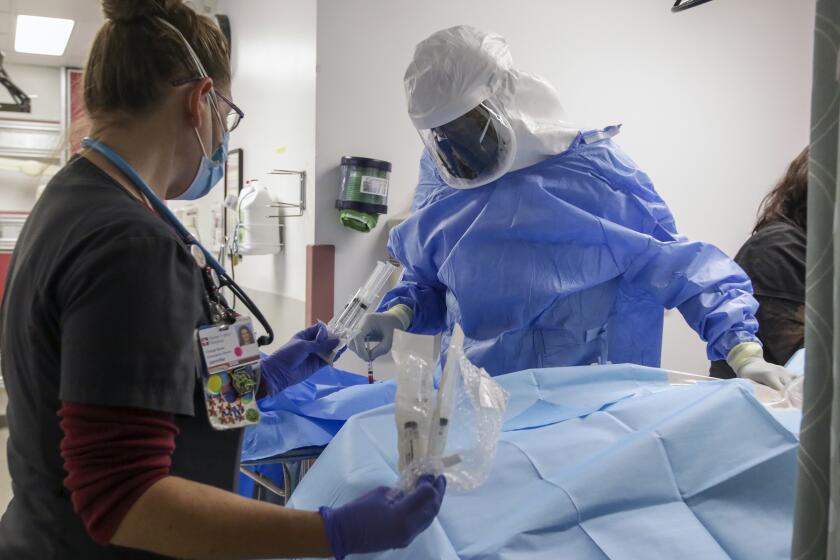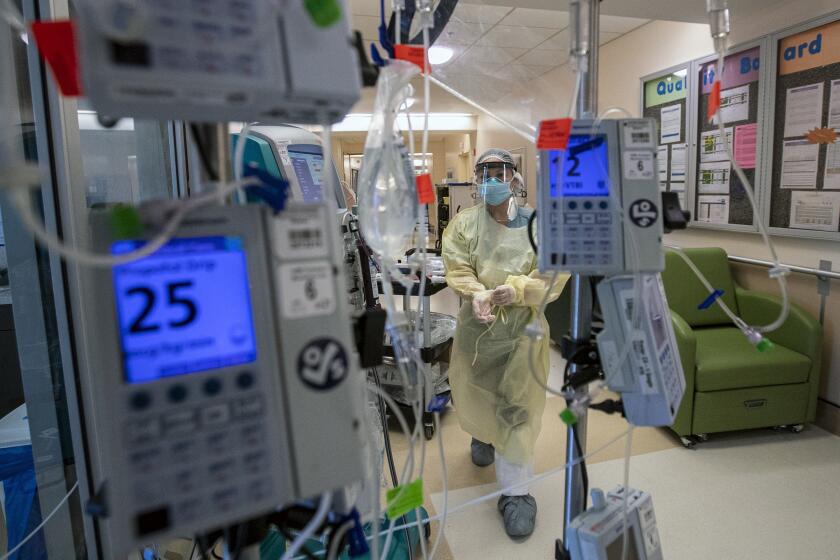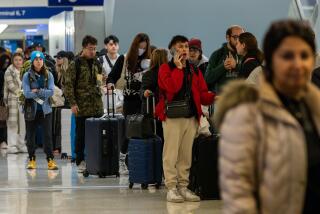Coronavirus has slammed the Inland Empire with exceptional fury. Here is why

- Share via
When the California National Guard was brought in to bolster an overworked staff at a Riverside County hospital last month, there were more intensive care patients than beds. To make room, Riverside Community Hospital converted a cafeteria into an overflow space.
Besides caring for the most COVID-19 patients in the county at the time, “our healthcare workers are also getting sick. In addition to that, they’re exhausted. And then we have a national nursing shortage,” said Chief Executive Jackie Desouza-Van Blaricum, explaining why she reached out for assistance.
Just over a week later and 15 miles away, a team of about 20 federal military medical personnel from the Department of Defense arrived at the Riverside University Health System Medical Center to help with its record number of patients.
Amid a coronavirus surge overwhelming hospitals across Southern California, Riverside County and the greater Inland Empire are experiencing some of the most dire conditions.
Infection rates have skyrocketed in the area in recent weeks. Over the last seven days, there were nearly 983 coronavirus cases for every 100,000 residents in Riverside County. The county trails only San Bernardino, which had about 1,012 cases for every 100,000 residents over the last week, according to The Times’ tally of local health jurisdictions.
Los Angeles County, long a hotbed of coronavirus infections, trailed both Inland Empire counties when infection rates were adjusted per capita. Over the last seven days, it has had about 957 new coronavirus cases per 100,000 residents.
The rising case counts invariably led to an increase in hospitalizations and, ultimately, deaths. On Wednesday, there were 1,634 patients hospitalized with COVID-19 in Riverside County, and 364 of them were in the ICU, according to state data.
Over the last seven days in Riverside County, about 200 people have died of COVID-19. The weekly death toll is the third-highest in the state when not adjusted for population size.
By comparison, Los Angeles County — which continually leads the state in COVID-19 deaths — has seen just over 1,280 deaths during the same period, six times the figure in Riverside, according to data tracked by The Times.
Public officials and experts point to several contributing factors behind the surge in Riverside County. The region is powered by a logistics and manufacturing industry that kicked into overdrive over the holidays, as online shopping — already up during the pandemic — increased.
Staffing the area warehouses and facilities are large numbers of essential workers, many of whom live in dense, working-class communities, where the virus has spread.
The Inland Empire has become the hotbed of the COVID-19 spread even as officials sue the state to ease restrictions.
County officials and law enforcement have also at times chafed against coronavirus restrictions, sending conflicting, if not contradictory, messages to residents.
In May, Riverside County’s Board of Supervisors voted to rescind all local stay-at-home orders that went beyond the governor’s restrictions at the time, including requirements to wear masks and maintain physical distance.
Riverside County Sheriff Chad Bianco has been an outspoken critic of the restrictions, announcing last month that his department would not enforce the state’s latest stay-at-home order. In a video, he called the rules “flat-out ridiculous.”
The variability in messaging “certainly helps to generate doubt, or lack of compliance, and undermines these kinds of imploring messages related to community,” said Richard Carpiano, professor of public policy and sociology at UC Riverside.
Perris, one of Riverside’s hardest-hit cities in terms of per-capita infections, passed a mask mandate around the time the county repealed its own. Mayor Michael Vargas said he’s been consistent in warning residents against gathering outside their households and has urged people to stay home as much as possible.
But many residents depend on jobs at manufacturing facilities where close working conditions can lead to outbreaks.
“A lot of our employees are working hour to hour,” Vargas said, “and they don’t have any healthcare behind them.”

Edward Flores, a sociology professor with the UC Merced Community and Labor Center, said such workers — who are often immigrants or lack legal residency status — might not be aware of their rights or fear reporting workplace issues. Perris, a city of about 80,000, is two-thirds Latino.
So-called culture wars, Flores said, can derail important policy discussions.
“We get stuck in these debates about wearing the mask or not wearing the mask,” he said. “That certainly does mitigate the spread of COVID-19 in an important way. But there’s still also these various structural factors that come into play. Because whether there’s stay-at-home orders or not, front-line essential workers are still going off to work.”
Riverside County spokeswoman Brooke Federico noted that all of Southern California has seen a surge in coronavirus cases and hospitalizations in recent weeks. So far, 1 in 16 people in the state have tested positive for the virus at some point during the pandemic. The number of new infections across the state is on pace to double roughly every six weeks, a number used to measure how quickly the virus is spreading.
Like many parts of the state, Riverside County has had cases increase after holidays; an upward trend has been in the works since Thanksgiving, Federico said.
“While outbreaks have occurred in several different types of industries, we also know that social gatherings have driven up cases,” Federico said in an emailed statement.
One of the largest hospitals in San Bernardino County ran out of ICU space two weeks ago amid an onslaught of coronavirus cases across Southern California.
Vargas said he thinks younger residents in particular are experiencing pandemic fatigue and may have ignored guidelines to celebrate New Year’s Eve and other holidays.
After struggling through pandemic-related restrictions, “they just want to go out and have a good time and party because of the rough time they had all year long,” he said.
Regardless of the reasons behind the surge, area hospitals are feeling the resulting strain.
“Riverside County hospitals have been stretched well-beyond their licensed capacities to treat a record numbers of patients,” Bruce Barton, director of the county’s Emergency Management Department, said in a statement.
In an attempt to ease the burden, the Federal Emergency Management Agency is deploying medical personnel to facilities in Riverside County and throughout California, after a request by state officials.
At the Riverside University Health System Medical Center, where the Department of Defense team is stationed, the staff is treating an average of 450 patients in its 439-bed hospital. Typically, the hospital treats an average of 350 patients, Jennifer Cruikshank, the medical center’s CEO, said in a statement.
The military medical team consists of physician assistants, nurses and respiratory care practitioners from the Army and Air Force.
Those temporary staffers “are breathing in a renewed energy and hope into our team that will help us continue to provide our expanded services and support the acute healthcare needs of more people in our region during this critical time,” Cruikshank said.
More to Read
Sign up for Essential California
The most important California stories and recommendations in your inbox every morning.
You may occasionally receive promotional content from the Los Angeles Times.













